
Water Conservation & Reclamation In San Diego County |
|
F1
What Is Water Conservation?
Simply defined, conservation means prevention of wasteful use of a resource. It also means the careful preservation and protection of resources.
Water conservation refers to the preservation and protection of water supply, the control and development of water resources (including both surface and groundwater), and prevention of pollution. Water conservation involves activities designed to reduce the demand for water, improve the efficiency of its use, and reduce losses and waste.
Water conservation also involves getting the maximum benefits from its use—and at lower costs. Measures to achieve this include development and use of water-saving devices and water-efficient processes. Public education is a critical factor to water conservation—getting people to recognize the value of water and not using it as if it were free and in unlimited supply. This may involve water demand management, water rationing, and water pricing. |
Click on images for a larger view! |
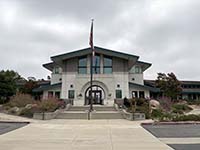
Fig. 1. Vallecitos Water District Office with gardens in San Marcos, California |
F2
How much water do we use?
A survey conducted in 2017 by the American Water Works Association (AWWA) found that the typical San Diego household pays about $80 a month for water. The AWWA also reported that the national average is less than $40 a month. The U.S. Environmental Protection Agency (EPA) reported that the average household in America uses about 300 gallons of water each day (this translates about 9,000 gallons or 1,200 feet3 per month). On average 70% of this water is for indoor use (Figure 2). In contrast, the San Diego County Water Authority reported in 2016 that the personal water consumption for residents in San Diego has dropped to about 120 gallons per day (this translates about 3,650 gallons or 490 feet3 per month). Note these numbers are difficult to translate into reality when you comparing water use to individuals across the spectrum of wealth in San Diego. Someone living in an apartment in Escondido, Oceanside, or Chula Vista will not be using nearly as much water as someone in a monster home with a large grassy lawn, such as in Rancho Santa Fe (the community with the highest per-capita water usage in San Diego County). |
Fig. 2.
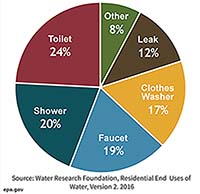
How water is used indoors.
|
F3
Water Education And Information Resources
Educating the public is perhaps the most important aspect of water conservation. Nearly every water district has a website that provides information about water conservation and water-related issues specific to the communities that they serve. Note that some districts provide better or more informative web-based resources than others. Many water districts provide "demonstration gardens" to illustrate water efficient and fire-safe gardening, using drought-tolerant native plant species. Water districts personnel often visit schools, community centers, and attend events, and offer tours of their facilities.
Government agencies also provide important information about water conservation. In California these include:
California Department of Water Resources (https://water.ca.gov/): The CA DWR manages California's water resources, systems, and infrastructure, including the State Water Project (SWP), in a responsible, sustainable way. DWR's "responsibilities and duties include:
- Preventing and responding to floods, droughts, and catastrophic events
- Informing and educating the public on water issues
- Developing scientific solutions
- Restoring habitats
- Planning for future water needs, climate change impacts, and flood protection
- Constructing and maintaining facilities
- Generating power
- Ensuring public safety
- Providing recreational opportunities."
California Water Resource Control Board (https://www.waterboards.ca.gov/) : Their mission is "to preserve, enhance, and restore the quality of California's water resources and drinking water for the protection of the environment, public health, and all beneficial uses, and to ensure proper water resource allocation and efficient use, for the benefit of present and future generations."
Federal agencies involved in water resource management research and conservation include the U.S. Geological Survey (Water Resources Division), U.S Fish and Wildlife Service, National Park Service, U.S Bureau of Land Management, and National Oceanographic and Atmospheric Administration. |
F4
Effective Protection and Restoration of Wetlands and Watershed Habitats
Protecting water quality in streams and rivers and groundwater is perhaps the most important (and expensive) aspect of conservation. Purchasing land for watershed protection is expensive (and political)! Safeguarding wild vegetation and wildlife on land and along stream valleys is perhaps the most efficient and effective way to conserve water and preserve water quality. Natural flowing streams through a variety of habitats actually filter and trap potential pollutants, naturally cleaning the water. Water districts and communities everywhere are now buying up land to be set aside as open spaces and wildlife refuges. Strong public support for watershed protection involves regulation and enforcement to mitigate environmental threats. Threats come from poorly planned urban development, unregulated agricultural practices, and industrial interests such as mining, energy, and chemical industries that are historically known to destroy habitats and pollute water resources. Homes in rural areas have septic systems that may be incompatible with nearby water wells. |
Fig. 3.

Escondido River in Elfin Forest (watershed area) |
F5
Waste Water Treatment Facilities
Nearly all municipalities have waste water treatment facilities; some are more efficient or effective than others. Modern systems are designed to process sewage waste water to remove solids. They then pass water through anaerobic and aerobic bacterial processes tanks and filtration to the point that water leaving the plant may actually meet standards for drinking water or municipal watering (parks, gardens, along roads, etc.). Often it is released back into streams or pumped into the groundwater (only to be used by the next community downstream). Solids waste from some treatment facilities is processed and distributed as fertilizer/soil enhancement products. Unfortunately, some plants are not capable with dealing with urban runoff, or older ones sometimes release raw sewage when their capacity is overloaded with storm runoff. This creates hazards in rivers, lakes, and coastal areas. |
Fig. 4.
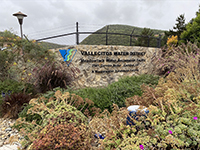
|
Fig. 5.
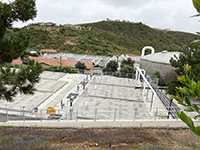 |
| The Vallecitos Water District, Meadowlark Water Reclamation Facility is an example of a modern wastewater treatment facility in Carlsbad, CA |
F6
Effective Capture Of Rainfall and Urban Runoff
Urban areas have problems with runoff from streets, parking lots, and roof tops where the design does not sufficiently capture rainfall. This is particularly bad during strong storms when drains cannot adequately capture all the runoff. Often the runoff contains trash, dirt, and other pollutants that end up being washed into streams and eventually the ocean. Whereas the city (or municipality) may be responsible for designing street drainage systems, they may not be able to control what their residents (homes and businesses) are doing with their runoff. Paved areas and buildings cover areas that in the natural environment would be covered with vegetation that would minimize runoff and allow precipitation to soak in, adding to the groundwater supply. A good alternative is to capture roof water in mosquito-proof barrels or cisterns, and use if for gardening after storms pass. Check to see if you water district has advice, or if they offer rebates on water storage devices. |
Fig. 6.
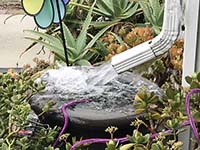 Roof water flowing into a water storage barrel Roof water flowing into a water storage barrel |
F7
Water Reclamation and Desalination Projects
As cities face shortages in their water supply, some are looking at alternative sources by desalinating seawater, salty groundwater, or processing graywater. San Diego Currently has the largest ocean-water desalination plant in the
the United Sates:
Carlsbad Desalination Plant (From their website: 'The Claude “Bud' Lewis Carlsbad Desalination Plant is the largest, most technologically advanced and energy-efficient seawater desalination plant in the nation. Each day, the plant delivers nearly 50 million gallons (56,000 acre-feet per year (AFY)) of fresh, desalinated water to San Diego County – enough to serve approximately 400,000 people and accounting for about one-third of all water generated in the County."
On a smaller scale, the Richard A. Reynolds Groundwater Desalination Facility in San Diego uses a reverse-osmosis desalination process to treat brackish (or saline) groundwater to make it safe for human use. At full capacity, facility can produce 10 million gallons of drinking water per day, enough for approximately 18,000 families.
|
F8
Identifying Point Source and Non-Point Sources of Pollutants
Municipalities overseeing watersheds are always trying to mitigate environmental pollution. Features like smoke stacks, mines, and wastewater pipeline outlets are examples of point-source pollution features that can be identified and regulated. It is the non-point sources of pollution that are difficult to regulate, such as car exhaust, animal wastes, cigarette butts, plastic trash, and residential yard chemicals, etc. (Figure 7). This is where education can play an important roll. For instance, replacing household cleaning products with environmentally-safe "organic remedies" (non-toxic), and to replace commercial weed killers and insecticides. For example, try these alternatives:
Weed killer:
a simple mix of 1 gallon white vinegar, 1 cup epson salt, and 1 cup Dawn dish soap is an inexpensive and effective alternative to a "popular commercial weed killer" containing glyposate (a potential carcinogen).
Ant killer: Borax kills sugar ants but won't harm humans or pets. Mix 1/2 cup sugar, 1 1/2 tablespoon Borax, and 1.5 cups of warm water. Soak tissue or cotton balls in the mixture, and put them out near the where ants are coming from. Sugar attracts the ants, and they'll take the Borax with it back to their nests. |
Fig. 7.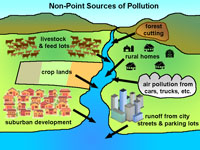
Non-point sources of water pollution include forest cutting, livestock, crop lands, rural homes, vehicle air pollution, suburban development, and runoff from streets and parking lots.
|
F9
How To Reduce Home and Businesses Water Consumption
There are many websites that offer suggestions on how to save water. Most local water municipalities provide an abundance of alternatives on their website. Some of the best suggestions for saving water bills at home include:
OUTSIDE YOUR HOME OR BUSINESS
- Use rock and gravel as ground cover for open yard areas (not water-intensive grass!). Artificial turf is initially expensive, but it can eventually pay for itself by cutting yard maintenance and watering expenses.
- Plant drought-tolerant plants: cactus, succulents, and native plants not only consume less water and may have fire resistant or fire retardant properties. Many parks and garden centers have demonstration gardens for ideas.
- Use mulch around plants in in gardens to capture and hold soil moisture.
- Use effective garden/plant watering
(irrigation control) - watering in the coolest part of the evening or morning reduces water loss through evaporation and allow water to seep deeper in to the soil.
- Do weather-based irrigation: stop watering 3 days before a storm, check soil moisture before resuming.
- Capture storm water that drains from roof tops: capture water is barrels or other mosquito-proof water storage contains. Dust in roof water tends to be rich in natural nutrients that fertilize garden plants.
INSIDE AND AROUND YOUR HOME OR BUSINESS
- Reuse graywater for watering plants - Graywater is water that drains from your shower, tub, bathroom sink, and clothes washer (as opposed to blackwater that drains from toilets, dishwashers, and disposal wastewater). This can be difficult to set up and take some getting used to, but it can save a lot of water!
- Find leaks such as around toilets, faucets, pools/spas, irrigation pipes, etc. Even a small leak can add up to significant water loss if ignored.
- Replace old fixtures with low-flow toilets, shower heads, and faucets.
- Replace old appliances (dishwashers, clothes washers, refrigerators) with new, more energy and water efficient appliances. Look for the Energy Star rating on the appliance before purchasing. Rebates and tax incentives may apply. (Note: EnergyStar.gov is a government sponsored program in support of energy efficiency products.)
|
Fix. 8.
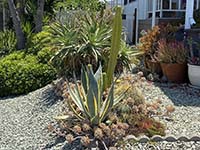 Dry climate gardening uses rock ground cover and plants that are drought tolerant (cactus, succulents, and native plants). Dry climate gardening uses rock ground cover and plants that are drought tolerant (cactus, succulents, and native plants).
Fig. 9.
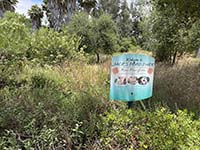
Example of a native plant garden in Jacks Pond Park in San Marcos. |
F10
Report Water Waste and Polluters!
Don't look the other way! This is an important way to save water. This is especially important when state or regional water restrictions are in effect.
Visit the State of California website https://savewater.ca.gov to report water waste anywhere in the state.
In San Diego County, you can also call the Water Waste Hot line and leave a voice mail at 619-533-5271 and report an address and description of the violation. Or send an email to waterwaste@sandiego.gov with information, including description and address.
Local municipalities have contact information to REPORT WATER WASTE AND POLLUTION - this website has links to most of the municipalities and departments throughout the county that deal with these topics. |
Fig. 10.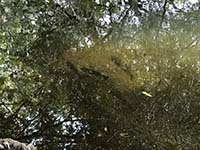
Fish swimming in the Escondido River in the Elfin Forest Recreational Reserve. |
F11
Does Your Home Rely On A Well and/or Septic System?
Many homes that are beyond urban areas rely on water wells to supply home water need. Likewise, often these homes also have septic systems to dispose of their blackwater. If you own a well, it is extremely important to get your well water tested frequently! Guidelines by the Department of Health in many States requires that new septic tanks or human-waste lagoons to be installed at least 50 feet from a well. Septic tank drain fields must be at least 100 feet from a well.
This can be problematic and potentially dangerous if wells and septic systems are too close together or that the flow of groundwater is connected is some way. In many parts of San Diego County the granitic bedrock is heavily fractured, and these unseen fractures can direct unfiltered flow of blackwater to nearby springs and wells. Also, it is important to note where your well or septic system is located relative to other nearby homes or buildings. As areas are developed (new homes added), especially in dry regions like San Diego County, the amount of blackwater entering the local groundwater system can ruin local water quality.
|
Fig. 11.

Diagram showing a home with a well and a septic system. |
F12
| Use tap water (filtered) over bottled water. All tap water in San Diego is tested frequently and is safe to drink. Residents are quickly warned is contamination is reported in the system. In contrast, bottled water is a lot more expensive than tap water and it may be have associated health risks. In addition, tap water does not contribute to the over abundance of plastic waste in the environment. Although not necessary, additional water filtration devices can be added to faucets and refrigerators, but these filters also require maintenance. |
F13
Take A Dip and Get Political!
Identify polluting entities, wasteful management, and opposing development that endangers watershed habitats is the right thing to do. However, some fights are too big to fight alone. Organizations like the Sierra Club and local meet-up groups are among the best way to find people with like-minded individuals interested in protecting watersheds and open space.
It is always good to encourage community leadership to build more hiking/biking trails. This increases property values and ultimately gets some cars off the road and helps people in communities to become a bit more caring about their environment.
Reorganizing land use is another goal. For example, many older communities built around golf courses are failing due to the cost of their maintenance and changing demographics. Golf courses are often among the worst water polluters and water wasters in communities that maintain them. Herbicides and pesticides used on golf courses eventually find their way into local watersheds and are commonly the worst source of pollution in watershed. Golf courses can be restored back to watershed open space at a great cost saving to community residents, but it could be a major political battle. Some communities associations may have no choice but through bankruptcy.
|
Fig. 12.
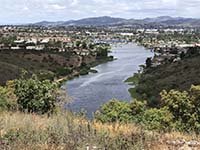
Lake San Marcos in the San Marcos Creek watershed. |
| https://gotbooks.miracosta.edu/earth_science/water/conservation.html |
6/29/2020 |
|

 Dry climate gardening uses rock ground cover and plants that are drought tolerant (cactus, succulents, and native plants).
Dry climate gardening uses rock ground cover and plants that are drought tolerant (cactus, succulents, and native plants).









